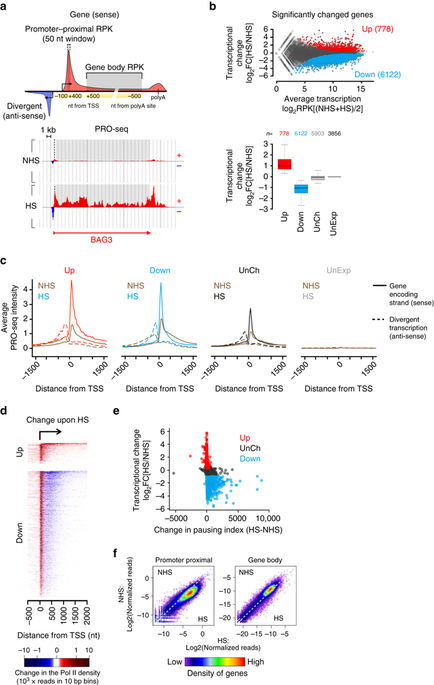当前位置:
X-MOL 学术
›
Nat. Commun.
›
论文详情
Our official English website, www.x-mol.net, welcomes your
feedback! (Note: you will need to create a separate account there.)
Transcriptional response to stress is pre-wired by promoter and enhancer architecture.
Nature Communications ( IF 14.7 ) Pub Date : 2017-08-15 , DOI: 10.1038/s41467-017-00151-0
Anniina Vihervaara 1, 2 , Dig Bijay Mahat 2 , Michael J Guertin 3 , Tinyi Chu 4, 5 , Charles G Danko 4 , John T Lis 2 , Lea Sistonen 1
Nature Communications ( IF 14.7 ) Pub Date : 2017-08-15 , DOI: 10.1038/s41467-017-00151-0
Anniina Vihervaara 1, 2 , Dig Bijay Mahat 2 , Michael J Guertin 3 , Tinyi Chu 4, 5 , Charles G Danko 4 , John T Lis 2 , Lea Sistonen 1
Affiliation

|
Programs of gene expression are executed by a battery of transcription factors that coordinate divergent transcription from a pair of tightly linked core initiation regions of promoters and enhancers. Here, to investigate how divergent transcription is reprogrammed upon stress, we measured nascent RNA synthesis at nucleotide-resolution, and profiled histone H4 acetylation in human cells. Our results globally show that the release of promoter-proximal paused RNA polymerase into elongation functions as a critical switch at which a gene's response to stress is determined. Highly transcribed and highly inducible genes display strong transcriptional directionality and selective assembly of general transcription factors on the core sense promoter. Heat-induced transcription at enhancers, instead, correlates with prior binding of cell-type, sequence-specific transcription factors. Activated Heat Shock Factor 1 (HSF1) binds to transcription-primed promoters and enhancers, and CTCF-occupied, non-transcribed chromatin. These results reveal chromatin architectural features that orient transcription at divergent regulatory elements and prime transcriptional responses genome-wide.Heat Shock Factor 1 (HSF1) is a regulator of stress-induced transcription. Here, the authors investigate changes to transcription and chromatin organization upon stress and find that activated HSF1 binds to transcription-primed promoters and enhancers, and to CTCF occupied, untranscribed chromatin.
中文翻译:

对应激的转录反应由启动子和增强子结构预先连接。
基因表达程序由一组转录因子执行,这些转录因子协调来自一对紧密连接的启动子和增强子核心起始区域的不同转录。在这里,为了研究发散转录如何在应激下重编程,我们以核苷酸分辨率测量了新生的 RNA 合成,并分析了人类细胞中的组蛋白 H4 乙酰化。我们的全球结果表明,启动子近端暂停 RNA 聚合酶释放到延伸中是决定基因对应激反应的关键开关。高度转录和高度诱导的基因在核心正义启动子上表现出很强的转录方向性和一般转录因子的选择性组装。相反,增强子的热诱导转录与细胞类型、序列特异性转录因子的先前结合相关。活化热休克因子 1 (HSF1) 与转录引发的启动子和增强子以及 CTCF 占据的非转录染色质结合。这些结果揭示了染色质结构特征,这些特征将转录定位在不同的调节元件和全基因组的引物转录反应上。热休克因子 1 (HSF1) 是应激诱导转录的调节因子。在这里,作者研究了应激下转录和染色质组织的变化,发现激活的 HSF1 与转录引发的启动子和增强子以及 CTCF 占据的未转录染色质结合。
更新日期:2017-08-15
中文翻译:

对应激的转录反应由启动子和增强子结构预先连接。
基因表达程序由一组转录因子执行,这些转录因子协调来自一对紧密连接的启动子和增强子核心起始区域的不同转录。在这里,为了研究发散转录如何在应激下重编程,我们以核苷酸分辨率测量了新生的 RNA 合成,并分析了人类细胞中的组蛋白 H4 乙酰化。我们的全球结果表明,启动子近端暂停 RNA 聚合酶释放到延伸中是决定基因对应激反应的关键开关。高度转录和高度诱导的基因在核心正义启动子上表现出很强的转录方向性和一般转录因子的选择性组装。相反,增强子的热诱导转录与细胞类型、序列特异性转录因子的先前结合相关。活化热休克因子 1 (HSF1) 与转录引发的启动子和增强子以及 CTCF 占据的非转录染色质结合。这些结果揭示了染色质结构特征,这些特征将转录定位在不同的调节元件和全基因组的引物转录反应上。热休克因子 1 (HSF1) 是应激诱导转录的调节因子。在这里,作者研究了应激下转录和染色质组织的变化,发现激活的 HSF1 与转录引发的启动子和增强子以及 CTCF 占据的未转录染色质结合。































 京公网安备 11010802027423号
京公网安备 11010802027423号